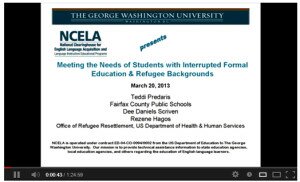There is growing consensus among researchers and policy makers about the design features, policies and practices that are working well to promote academic success for students with interrupted schooling.
Best practice features include:
A programming plan that incorporates instructional modifications:
- Age-appropriate grouping
- Self-contained program or classroom offering intensive, accelerated English, literacy and numeracy instruction for at least the first year or two
- Intensive small group or individual literacy interventions
- Well-articulated transition plans that enable students to access “regular” ESL classes and mainstream classes as appropriate, when ready
- Provisions for ESL/Literacy teachers to plan with and work alongside mainstream teachers in mainstream classrooms to support LFS learners
- Provision of first language educational assistants or tutors, if possible
- Extended high school experience
- Modified scheduling and provision for extended day and “out-of-school” learning time.
- See also: Youth Literacy Canada – promising practices.
A whole school community approach to serve the academic and social needs of students:
- Access to a range of recreational sport and arts activities
- Access to a range of services including tutoring, mentoring, counselling, home-school liaison, and community services to address resettlement, socio-emotional needs and educational and career planning. See Wraparound Support.
- Coordinated efforts to involve culturally diverse parent and community groups
- Whole family supports including family learning and family literacy components. See Family Supports.
- Assisting parents to understand the school system. See Sample Parent Guides (Translated into many languages)
For more detail, see:
Click here (for #1) here (for #2) or on the images below to view two recently archived NCELA webinars at which these practices are discussed.
Serving ELLs With Limited or Interrupted Education: Intervention That Works
How to Support ELL Students with Interrupted Formal Education
Effective Programs for English Language Learners with Interrupted Formal Education
See also the Links: Instructional Design resources in the toolkit.
See also the Literature Review and the References section.
To see examples of how some jurisdictions have implemented these practices, go to the Sample Models page.






